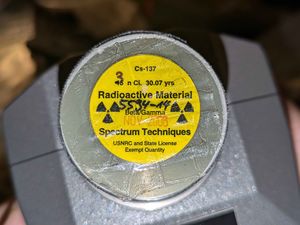ICX identiFINDER
Originally made by ICX Radiation which was then acquired by Thermo Scientific
"FWIW my source is labeled 1uCi and dated to Jul 2006 (also from Spectrum Techniques)
it reads ~3uSv/h on my spectrometer, which some napkin math tells me it should be ~0.1uCi
though the decay calculator says it should be 0.65uCi
In the non-Ultra models a built-in Cs-137 reference source (<15 nCi/500 Bq) is used for online stabilization and in-situ calibration without user interaction.
this is interesting. I assume your unit does not have an internal source"
"figured a bit more out with the my identifinder, it is complaining about the backup battery being dead (seems to be a smaller battery soldered in the unit) and is loosing its calibration on each bootup. From what I have been able to gather, the cs-137 calibration is mandatory at first boot but them it switches over to the blue led calibration on subsequent power cycles. That probably explains the smaller check source: on the standard it runs a 30s calibration with the 15nCi source at each boot, whereas in the ultra is runs a 180s calibration on the 3nCi once to calibrate the blue LED and then does a blue LED calibration (every 5s apparently)
there is also some sort of background subtraction that it does with the check source, the cs-137 spectrum peak doesn't show up in the downloaded spectrum. If you put an additional source you can still get counts there so its isn't just completely blanking out the area. not quite sure how it works, must just selectively delete some counts"
Blue cap bs red cap?
Took mine apart to investigate the dead backup battery and found some tantalizing dip switches. The GM tube is a 716 (comically tiny!) and the He3 tube is a 3He3/608/15FS. The 716 datasheet is readily available, but the He3 tube seems to be smaller than the normal catalog goes but I found the datasheet for a larger tube. 608 seems to stand for 8bar fill
Battery pack
"I did end up ordering a main battery for mine, they are still available from FLIR in both nicad and removable battery (takes 4x AA) version. Almost would have been cheaper to buy another burner unit, it was almost $250 with tax and shipping"
Backup battery
hmm so there is good news and bad news, the good news is the battery is a pretty lithium primary cell i a 'cr-1/3n' package from FDK. The bad news is that there aren't any available from the usual digikey etc with tabs
found what appears to be a pretty much oem replacement here https://www.battery2batteries.com/fdk-cr1-3n-pc3-battery-3-pin/
Battery2Batteries.com
FDK CR1/3N-PC3 Battery (3 Pin)
Buy Now - FDK CR1/3N-PC3 Battery (3 Pin) - Replacement for CR1/3N-3PIN, CR1/3N-SLF, CR-1/3N-3PIN, CR-1/3N-SLF, CR1/3N-PC3
Image
I am kinda 50/50 split on ordering from him, shipping is another $15 so it ends up a pretty pricey battery
probably just going to install a normal cr2032 I have on hand
Cal source
Peter unit: 3 nCi (hand written, 15 nCi crossed out)
McMaster order 2024-08
- 15 nCi seems to be the standard source
- 50 nCi are the lowest COTS source (link)
- However they are made to order, so you can get a smaller one if needed. In theory down to about 3 nCi. Contact them for details
Serial port
messing around a bit with the software, it is pretty basic but mostly functions. basically, from what I have been able to gather it doesn't actually control the unit in any way but it lets you pull the data off. Seems to be working to manually set up an acquisition and then clicking the 'load actual spectrum' button which grabs the current counts and displays it (it adds to the currently displayed spectrum). The software itself has that early 2000s clucky vibe (not unlike the skyscan...) but was able to make a plot
when the software starts up it sends 'serial' and gets a text response with the serial number
I haven't tried sniffing in operation, but despite what the manual suggests none of the buttons do anything except the 'grab spectrum'
so far the process has all been pretty clunky, you first need to create a text file in the install folder with some magic incantations from the manual. Furthermore, the manual says the unit should be at 9600 baud but mine is at 38.4k (even after factory reset) so that took a bit of guess work
oh also, don't be fooled by the usb-shaped port. It is actually RS232
also some weird behavior that confused me, it seems like the max232 chip is powered by the data lines (?!) internal to the unit. I didn't see normal rs232 voltages until I hooked up the rx pin, then the tx pin started working. Very weird

